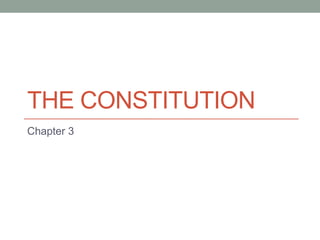
Chapter 3 The Constitution
- 2. The Six Basic Principles • The Constitution originally consisted of a Preamble, or introduction, and seven sections called articles. • The Framers developed the Preamble and articles around the six broad ideas, or principles, described below: • 1 – Popular Sovereignty • 2 – Limited Government • 3 – Separation of Powers • 4 – Checks and Balances • 5 – Judicial Review • 6 – Federalism
- 3. The Six Basic Principles • Popular Sovereignty is the idea that people are the • • • • • source of all power held by the government. Limited Government means that the government possesses only the powers the people give it – it must obey the Constitution. This principle is also known as constitutionalism. Government officials are subject to the rule of law – they must always obey the law and are never above it. Separation of Powers establishes three separate parts, or branches, that share the government’s power. These branches are the executive, the legislative, and the judicial.
- 4. The Six Basic Principles • The Constitution uses a system of checks and balances to ensure that none of the three branches can become too powerful. • Each branch has ways to limit the power of the other two. • An example of this principle is the power of the President to veto, or reject, any act of Congress. • Congress may then override a veto with a twothirds vote in each house.
- 5. The Six Basic Principles • Judicial Review is the power of the courts to decide what the Constitution means. • The courts also have the power to declare a government action to be against the Constitution, or declare the action unconstitutional. • Lastly, the Framers used the principle of Federalism to divide power between the central government and the States.
- 6. Formal Amendment • The Constitution has lasted more than 200 years because it has changed with the times. • Many of its words and their meanings are the same, but some words have been changed, eliminated, or added – and some of the meanings have been modified as well. • The alterations to the Constitution have occurred in two ways: either through formal or informal amendments, or changes.
- 7. Formal Amendment • A formal amendment is a change to the Constitution’s • • • • • written words. The Framers created four ways to make such a change. Method 1: Congress Proposes then State Legislatures ratify. Method 2: Congress Proposes the State Conventions ratify. Method 3: National Convention Proposes and State Legislatures ratify. Method 4: National Convention Proposes and State Conventions ratify.
- 8. Formal Amendment • The Framers followed the principle of federalism in creating these methods. • Amendments are proposed, or suggested, at a national level – either by Congress or at a national convention. • Then they are ratified at the State level – either in the State legislatures or by State conventions. • This method 1 has been used for all but one of the 27 amendments.
- 9. Formal Amendment • The first ten amendments are called the Bill of Rights. • Congress proposed all of them in 1789 because many people refused to support the Constitution unless the Federal Government protected these basic rights. • The States approved these ten amendments in 1791. • The other 17 amendments became part of the Constitution one at a time.
- 10. Informal Amendment • Many informal amendments to the Constitution have been made since 1787. • Unlike formal amendments, these have not changed the Constitution’s actual word. • These changes have come from five sources: • 1 – Congress has made changes to the Constitution through two kinds of basic legislation. First, it has passed laws that fill in details about the specific ways the government operates. Second, it has passed thousands of laws that explain certain parts of the Constitution.
- 11. Informal Amendment • 2 – The way Presidents have used their powers has produced some informal amendments. For example, a president may choose to make an executive agreement, or pact, with the head of another country instead of a treaty, or a formal agreement between two sovereign countries that requires Congressional approval. • 3 – The courts, especially the U.S. Supreme Court, have informally changed the Constitution by explaining parts of it when ruling on cases. The also decide if the government actions are constitutional or unconstitutional.
- 12. Informal Amendment • 4 – Political parties have informally shaped what the government does. For example, the parties have decreased the importance of the electoral college, the group that formally selects the nation’s President. • 5 – Customs are the usual ways people do things. Many customs have developed in American government that are not mentioned in the Constitution. For example, the President’s Cabinet, or advisory body, is customarily made up of the heads of executive departments and other officers. Senatorial courtesy is a custom in which the Senate will not approve a presidential appointment to serve in a Sate if the appointment is opposed by a senator from the President’s party.
- 13. Informal Amendment • Sources of Informal Amendments to the Constitution: • Basic legislation (laws). • Executive action. • Court decisions. • Party practices. • Customs.